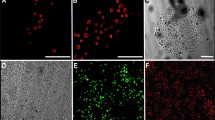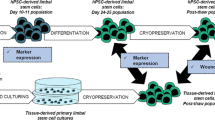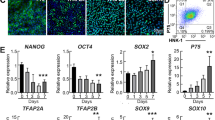Abstract
Rhesus putative epidermal stem cells are being investigated for their potential use in regenerative corneal epithelium-like cells, which may provide a practical source of autologous seed cells for the construction of bioengineered corneas. The goal of this study was to investigate the potential of epidermal stem cells for trans-differentiation into corneal epithelium-like cells. Rhesus putative epidermal stem cells were isolated by type IV collagen attachment method. Flow cytometry analysis, immunohistology and RT-PCR were conducted to identify the expression of specific markers (β1m α6 integrin, K15, K1/K10, K3/K12 and CD71) on the isolated rapid attaching cells. The isolated cells were cocultured with human corneal limbal stroma and corneal epithelial cells. After coculture, the expression of the same specific markers was evaluated in order to identify expression difference caused by the coculture conditions. K3/K12 expression was analyzed in coculture cells on day 2, 4, 6, 8 and 10. Putative epidermal stem cells in conditioned culture media were used as control. Putative epidermal stem cells were predominant in rapid attaching cells by type IV collagen attachment isolation. Before being cocultured, the rhesus putative epidermal stem cells expressed K15, α6 and β1 integrin, but no CD71, K1/K10 and K3/K12. After coculture, these cells expressed K3/K12 (a marker of corneal epithelial cells), K15 and β1 integrin, but no K1/K10. Cells being not coculture converted into terminally differentiated cells expressing K1/K10. These results indicate that rhesus putative epidermal stem cells can trans-differentiate into corneal epithelium-like cells and, therefore, may have potential therapeutic application as autologous seed cells for the construction of bioengineered corneas.
Similar content being viewed by others
References
Whitcher J P, Srinivasan M, Upadhyay M P. Corneal blindness: A global perspective. Bull World Health Organ, 2001, 79(3): 214–221
Tsai R J, Li L M, Chen J K. Reconstruction of damaged corneas by transplantation of autologous limbal epithelial cells. N Engl J Med, 2000, 343(2): 86–93
Griffith M, Osborne R, Munger R, et al. Functional human corneal equivalents constructed from cell lines. Science, 1999, 286(5447): 2169–2172
Griffith M, Hakim M, Shimmura S, et al. Artificial human corneas: Scaffolds for transplantation and host regeneration. Cornea, 2002, 21(Supp 7): S54–61
Carlsson D J, Li F, Shimmura S, et al. Bioengineered corneas: How close are we? Curr Opin Ophthalmol, 2003, 14(4): 192–197
Wang Z C, Ge J, Huang B, et al. Differentiation of embryonic stem cells into corneal epitheliuml. Sci China Ser C-life Sci, 2005, 48(5): 471–480.
Vogel G. Harnessing the power of stem cells. Science, 1999, 283(5407): 1432–1434
Mckay R. Stem cells—hype and hope. Nature, 2000; 406(6794): 361–364.
Kuehnle I, Goodell M A. The therapeutic potential of stem cells from adults. BMJ, 2002, 325(7360): 372–376
Peng H M, Chen G A. Neural precursors derived from human embryonic stem cells. Science in China Series C-Life Sciences. 2005, 48(3): 295–299.
Toma J G, Akhavan M, Fernandes K J, et al. Isolation of multipotent adult stem cells from the dermis of mammalian skin. Nat Cell Biol, 2001, 3(9): 778–784
Xue Q, Liu J, Sun H, et al. Superficial Skin Cell Culturing in vitro (in Chinese). Beijing: Science Press, 2001. 409–421
Jones P H, Harper S, Watt F M. Stem cell patterning and fate in human epidermis. Cell, 1995, 80(1): 83–93
Jeng W, Cooper D R, Bittle P et al. Aquaporin-1 expression in proximal tuble epithelial cells of human kidney is regulated by hyperosmolarity and contrast agents. Biochem Biophys Res Com, 1999, 256(1): 240–248
Li A, Simmons P J, Kaur P. Identification and isolation of candidate human keratinocyte stem cells based on cell surface phenotype. Proc Natl Acad Sci USA, 1998, 95(7): 3902–3907
Braun K M, Niemann C, Jensen U B, et al. Manipulation of stem cell proliferation and lineage commitment: visualisation of label-retaining cells in wholemounts of mouse epidermis. Development, 2003, 130(21): 5241–5255.
Yang X, Cao B, Feng X, et al. Cloning and induction of adult goat skin stem cells. Chinese J Reconstructive Surgery (in Chinese), 2003, 17(2): 93–96
Reubinoff B E, Pera M F, Fong CY, et al. Embryonic stem cell lines from human blastocysts: Somatic differentiation in vitro. Nat Biotechnol, 2000, 18(4): 399–404
Gritti A, Vescovi A L, Galli R. Adult neural stem cells: Plasticity and developmental potential. J Physiol Paris, 2002, 96(1–2): 81–90
Fuchs E, Segre J A. Stem cells: A new lease on life. Cell, 2000, 100(1): 143–155
Tsai Rt Y, Kittappa R, McKay R G. Plasticity, niches, and the use of stem cells. Developmental Cell, 2002, 2(6): 707–712
Zheng M, Wang D M, Jiao W C, et al. Neural stem cell amplified and differentiated into dopaminergic neural cell in vitro. Chin Sci Bull, 2003, 48(10): 1041–1044
Watt F M, Hogan B L. Out of Eden: Stem cells and their niches. Science, 2000, 287(5457): 1427–1430
Gekas C, Dieterlen-Lièvre F, Orkin S H, et al. The placenta is a niche for hematopoietic stem cells. Developmental Cell, 2005, 8(3): 365–375
Alison M R, Poulsom R, Jeffery R, et al. Hepatocytes from non-hepatic adult stem cells. Nature, 2000, 406(6793): 257
Ferrari G, Cusella-De Angelis G, Coletta M, et al. Muscle regeneration by bone marrow derived myogenic prognitors. Science, 1998, 279(5356): 1528–1530
Brazelton T R, Rossi F M, Keshet G I, et al. From marrow to brain: expression of neuronal phenotypes in adult mice. Science, 2000, 290(5497): 1775–1779
Mezey E, Chandross K J, Harta G, et al. Turning blood into brain: Cells bearing neuronal antigens generated in vivo from bone marrow. Science, 2000, 290(5497): 1779–1782
Pereira R F, O’Hara M D, Laptev A V, et al. Marrow stromal cells as a source of progenitor cells for nonhematopoietic tissues in transgenic mice with a phenotype of osteogenesis imperfecta. Proc Natl Acad Sci USA, 1998, 95(3): 1142–1147
Bjornson C R, Rietze R L, Reynolds B A, et al. Turning brain into blood: A hematopoietic fate adopted by adult neural stem cells in vivo. Science, 1999, 283(5401): 534–547
Clarke D L, Johansson C B, Wilbertz J, et al. Generalized potential of adult neural stem cells. Science, 2000, 288(5471): 1660–1663
Jackson K A, Mi T, Goodell M A. Hematopoietic potential of stem cells isolated from murine skeletal muscle. Proc Natl Acad Sci USA, 1999, 96(25): 14482–14486
Jang Y Y, Collector M I, Baylin S B, et al. Hematopoietic stem cells convert into liver cells within days without fusion. Nature, 2004, 6(6): 532–539
Belicchi M, Pisati F, Lopa R, et al. Human skin-derived stem cells migrate throughout forebrain and differentiate into astrocytes after injection into adult mouse brain. J Neurosci Res, 2004, 77(4): 475–486
Coulombre, J L, Coulombre A J. Metaplastic induction of scales and feathers in the corneal anterior epithelium of the chick embryo. Dev Biol, 1971, 25(3): 464–478
Yang Z M, Tong Y X. The uitrastructure of tadpole paranecrotic skin during the process of induction and differentiation into cornea. Acta Biol Exp Sin (in Chinese), 1988; 21(4): 443–455
Zhang H W. Developmental Biology (in Chinese). Beijing: Higher Education Press, 2001
Taylor G, Lehrer M S, Jensen P J, et al. Involvement of follicular stem cells in Forming not only the follicle but also the epidermis. Cell, 2000, 102(2): 451–461
Huang B, Wang Z C, Ge J, et al. A pilot study on transdifferentiation of skin stem cell in reconstructing corneal epithelium. Chin Med J, 2004, 84(10): 838–842
Morasso M I, Tomic-Canic M. Epidermal stem cells: The cradle of epidermal determination, differentiation and wound healing. Biol Cell, 2005, 97(3): 173–183
Pearton D J, Ying Y, Danielle D, et al. Transdifferentiation of corneal epithelium into epidermis occurs by means of a multistep process triggered by dermal developmental signals. Proc Natl Acad Sci USA, 2005, 102(10): 3714–3719
Gambardella L, Barrandon Y. The multifaceted adult epidermal stem cell. Curr Opn Cell Biol, 2003, 15(6): 771–777
Ferraris C, Chevalier G, Favier B, et al. Adult corneal epithelium basal cells possess the capacity to activate epidermal, pilosebaceous and sweat gland genetic programs in response to embryonic dermal stimuli. Development, 2000, 127(24): 5487–5495
Pearton D J, Ferraris C, Dhouailly D. Transdifferentiation of corneal epithelium: evidence for a linkage between the segregation of epidermal stem cells and the induction of hair follicles during embryogenesis. Int J Dev Biol, 2004, 48(2–3): 197–201
Fu X, Sun X, Li X, et al. Dedifferentiation of epidermal cells to stem cells in vivo. Lancet, 2001, 358(9287): 1067–1068
Fu X B, Sun X Q, Sun T Z, et al. Epidermal growth factor induces the epithelial stem cell island formation in the regenerated epidermis. Chin Med J, 2001, 81(12): 733–736
Watt F M, Hogan B L. Out of Eden: Stem cells and their niches. Science, 2000, 287(5457): 1427–1430
Janes S M, Lowell S, Hutter C. Epidermal stem cells. J Pathol, 2002, 197(4): 479–491
Author information
Authors and Affiliations
Corresponding author
Additional information
Supported in part by Hi-tech Research and Development Program of China (Grant No. 2003AA205005), the Specialized Research Fund for the Doctoral Program of Higher Education (SRFDP, No.20030558074), the Key Technologies Research and Development Programme of the Tenth Five-Year Plan (Grant No. 2004BA720A15), Scientific and Technological Program (Grant Nos. A3020101 and 2003A3020401) of Guangdong Province
Rights and permissions
About this article
Cite this article
Gao, N., Wang, Z., Huang, B. et al. Putative epidermal stem cell convert into corneal epithelium-like cell under corneal tissue in vitro . SCI CHINA SER C 50, 101–110 (2007). https://doi.org/10.1007/s11427-007-0006-4
Received:
Accepted:
Issue Date:
DOI: https://doi.org/10.1007/s11427-007-0006-4




